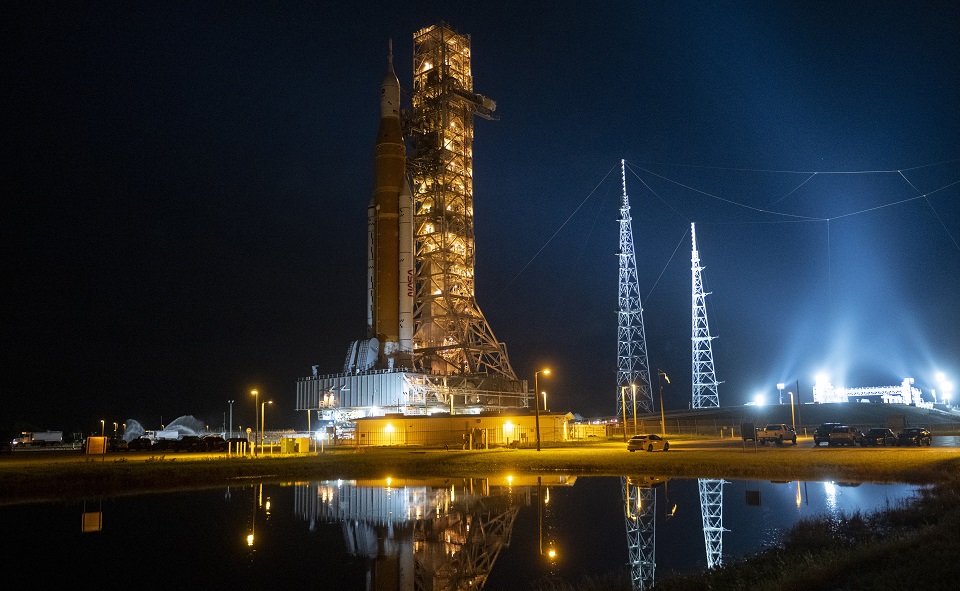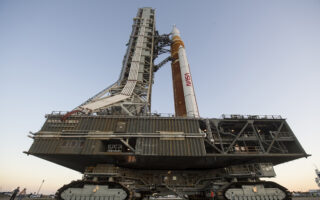NASA will try to launch moon rocket after 2 scrubs and 2 hurricanes

KENNEDY SPACE CENTER, Fla. – Last Thursday, NASA’s giant new multibillion-dollar rocket was standing on the launchpad in the middle of Hurricane Nicole.
The rocket, known as the Space Launch System and standing 322 feet tall with its payload on top, appears to be pretty hurricane resistant.
“If we didn’t design it to be out there in harsh weather, we picked the wrong launch spot,” Jim Free, NASA’s associate administrator for exploration systems, said in a news conference Friday after the storm had passed.
Less than a week after the buffeting by Nicole, the rocket could head to the moon very early Wednesday morning. If it gets off the ground, NASA will finally overcome a series of technical difficulties and weather interruptions that have delayed the Space Launch System’s debut, as well as the beginning of the lengthy journey to putting astronauts back on the moon.
Liftoff is scheduled for 1.04 a.m. Eastern time. The two-hour launch window, until 3.04 a.m., gives time to troubleshoot any problems or wait out bad weather. Forecasts give a 90% chance of favorable conditions. NASA TV will begin live video coverage of the launch countdown at 10:30 p.m. Tuesday.
This flight, known as Artemis I, will not have any astronauts aboard. It is intended to test the rocket as well as the Orion crew capsule, where astronauts will ride. After the launch, the Orion capsule will head to the moon, spending a couple of weeks in lunar orbit before returning to Earth for a splashdown in the Pacific in December.
NASA has had an eventful year. In July it released the first images from the James Webb Space Telescope, providing new views of objects deep in the cosmos and closer to home in our solar system. Then in September, it successfully completed the Double Asteroid Redirection Test mission, crashing a robotic space probe into a small asteroid to test a method for deflecting deadly space rocks in the future.
But the formal beginning of its Artemis program to return astronauts is coming years later than originally planned.
NASA first attempted to launch Artemis I on August 29. But the countdown was stopped after temperature readings indicated that one of the four engines on the core booster stage was not sufficiently cold. After studying the data, engineers concluded there was just a faulty sensor giving inaccurate readings.
During a second launch attempt September 3, the countdown was halted again, this time by a leak in the line filling ultracold liquid hydrogen into the rocket’s propellant tanks.
NASA spent weeks troubleshooting the issue on the launchpad and hoped to try again. But the uncertain path of Hurricane Ian, which devastated parts of Southwest Florida in late September, led to the rocket’s being rolled back to the shelter of the giant Vehicle Assembly Building, or VAB.
The rocket trundled to the launchpad November 4. At the time, Nicole was still an unnamed disturbance in the Atlantic Ocean, and forecasters did not expect a storm to form and strengthen into a hurricane. By the time it did, NASA managers realized that they did not have time to safely put the rocket back indoors, and they decided it leave it outside.
“I think it’s safe to say, for all of us, we obviously would not have wanted to stay out there,” Free said. “The best place for the vehicle in those kinds of things is the VAB We could not make it back to the VAB and be safe.”
During the hurricane, a 100-mph gust was recorded at the launchpad – but that was near the top of one of the lightning towers, higher than the rocket. Free said that the winds closer to the ground had not exceeded the vehicle’s design specifications.
Inspections revealed some minor damage, including some to a strip of caulk from the Orion crew capsule that sits on top of the rocket. On Monday, engineers finished an analysis that showed the missing 10 feet of caulk, added to smooth the flow of air during liftoff, would not cause problems.
“We’re comfortable flying as is,” Michael Sarafin, the Artemis mission manager, said Monday evening.
Whether the agency has successfully solved all of the technical glitches that interrupted the August and September launch attempts will not be known until the countdown. Engineers were not able to definitively identify the cause of the hydrogen leak that stymied the September 3 countdown. But they tried to fix all of the possible problems.
NASA managers insist that they will not launch until they are ready. However, for a new rocket, this one is getting pretty old. The rocket stages was stacked into the launch configuration more than a year ago, and rockets generally are not maintained in this vertical orientation indefinitely. The propellant in the two solid rocket boosters attached to the core booster can begin to sag, potentially affecting how it burns.
The current certification for the two side boosters, which were assembled in March 2021, expires next month. That does not mean that they will no longer work, but engineers will need to reanalyze their data. NASA has already extended the certification several times.
Even as Artemis I remains on the ground, a smaller piece of the Artemis program arrived at the moon. CAPSTONE, a 55-pound CubeSat, entered orbit around the moon on Sunday, four and a half months after it launched. The probe’s job is to study an orbit that is to be used for a future outpost where astronauts would stop on the way to the lunar surface.
CAPSTONE had its own share of unplanned excitement.
Right after launch, mission controllers lost contact with CAPSTONE because of an inadvertent command sent to the spacecraft that told it to turn off its radio.
“That was pretty terrifying,” said Thomas Gardner, the program manager for the mission at Advanced Space, a small Colorado company that built the spacecraft and operates it. “We weren’t sure exactly what had happened, but once you figured it out, it was pretty easy to make sure it never happened again.”
In July, after thrusters were fired to adjust CAPSTONE’s course to the moon, contact was lost again. This time, a valve for one of the thrusters stuck, sending the spacecraft into a spin. Over the next few weeks, engineers successfully restored communications, diagnosed the problem and stopped the spin.
Because CAPSTONE took the slow, fuel-efficient trajectory to the moon, engineers had time to troubleshoot before the spacecraft passed its destination.
This article originally appeared in The New York Times.






